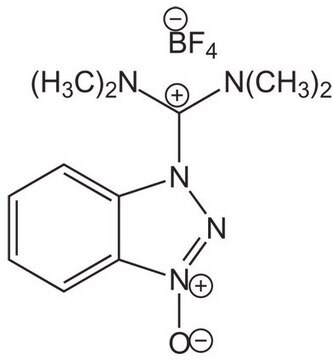54802
1-Hydroxybenzotriazole hydrate
≥97.0% dry basis (T), for peptide synthesis
Synonyme(s) :
HOBt Hydrate
About This Item
Produits recommandés
product name
1-Hydroxybenzotriazole hydrate, ≥97.0% dry basis (T)
Niveau de qualité
Pureté
≥97.0% dry basis (T)
Forme
solid
Composition
water, ~12%
Capacité de réaction
reaction type: Addition Reactions
Pf
155-158 °C (lit.)
Solubilité
DMF: 0.1 g/mL, clear
Application(s)
peptide synthesis
Chaîne SMILES
[H]O[H].On1nnc2ccccc12
InChI
1S/C6H5N3O.H2O/c10-9-6-4-2-1-3-5(6)7-8-9;/h1-4,10H;1H2
Clé InChI
PJUPKRYGDFTMTM-UHFFFAOYSA-N
Vous recherchez des produits similaires ? Visite Guide de comparaison des produits
Catégories apparentées
Description générale
Application
- Poly-γ-glutamic acid methyl ester from a dimer of γ-glutamic acid.
- Oxadiazoles via cyclo condensation of amidoximes with trifluoroacetic anhydride or benzoic acid derivatives.
Autres remarques
Mention d'avertissement
Danger
Mentions de danger
Conseils de prudence
Classification des risques
Aquatic Chronic 3 - Desen. Expl. 2 - Eye Irrit. 2
Code de la classe de stockage
4.1A - Other explosive hazardous materials
Classe de danger pour l'eau (WGK)
WGK 1
Point d'éclair (°F)
314.6 °F
Point d'éclair (°C)
157 °C
Faites votre choix parmi les versions les plus récentes :
Déjà en possession de ce produit ?
Retrouvez la documentation relative aux produits que vous avez récemment achetés dans la Bibliothèque de documents.
Les clients ont également consulté
Notre équipe de scientifiques dispose d'une expérience dans tous les secteurs de la recherche, notamment en sciences de la vie, science des matériaux, synthèse chimique, chromatographie, analyse et dans de nombreux autres domaines..
Contacter notre Service technique









